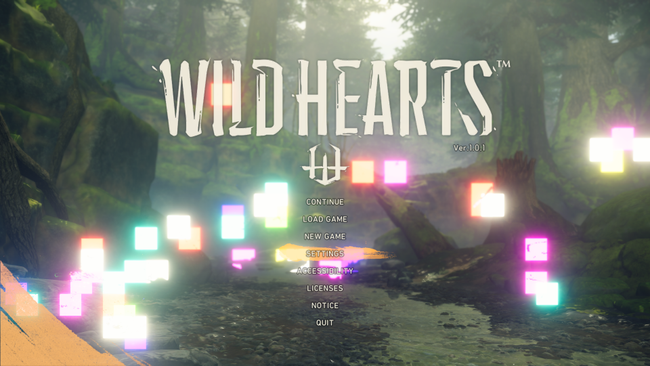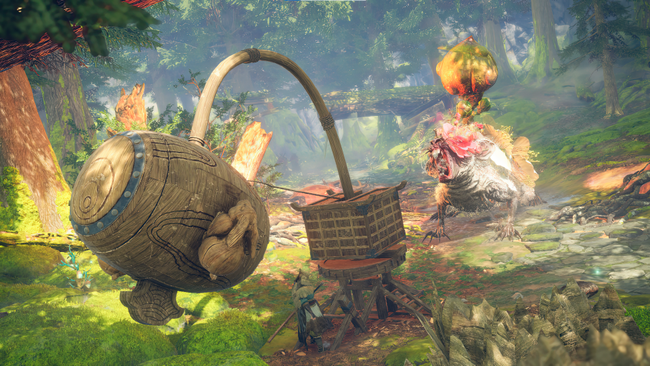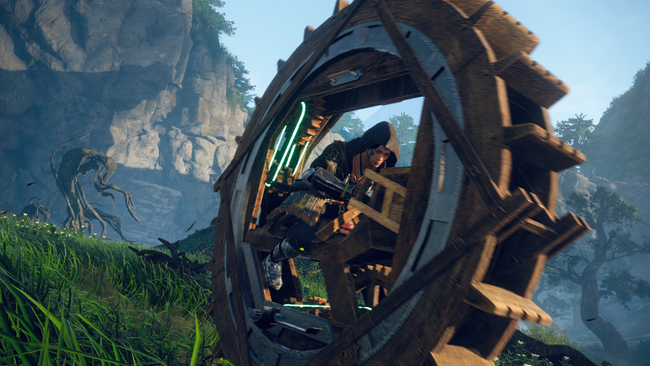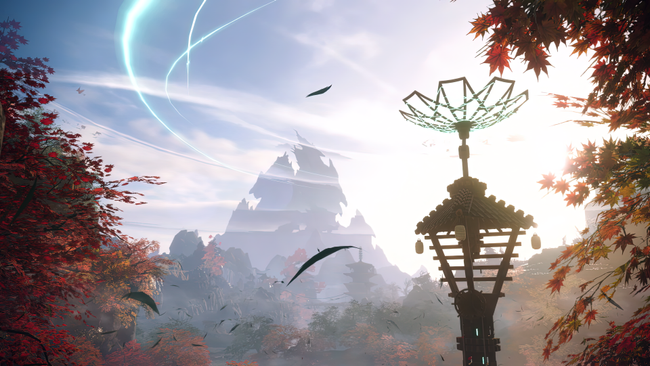
Wild Hearts Review
One of the worst feelings you can have when reviewing a game, is the feeling that technical shortcomings are what holds a truly special game back - and never has that been more true than with Wild Hearts, Koei Tecmo and EA's collaboration on a new Hunting Action RPG. Hidden between performance hiccups and graphical shortcomings - not to mention unplayable bugs for specific PC hardware configurations - it would be very easy to overlook what is otherwise an excellent game.
First things first; if you're using an AMD RDNA3 graphics card in your PC, until further notice the game is completely unplayable on such configurations. While it will boot, unfortunately, the game is plagued by graphical corruption that is seemingly tied to the engine's SSR implementation. While you can reduce the corruption by lowering your in-game Reflections setting to a lower quality preset, this doesn't alleviate the corruption entirely, and especially for anyone suffering from a risk of epilepsy it's unadvised to boot up the game until it's been confirmed fixed. We reached out to an AMD Radeon developer, who confirmed that the issue isn't an AMD driver problem, and an EA representative suggested that a fix for the issue would come with the game's next major patch next week, alongside performance and graphical improvements.
Even outside of the frankly unacceptable issue outlined above - the state of the game on both consoles and PC leaves a lot to be desired. While I'd expected as much that I would only be able to reasonably maintain 1080p/30FPS on my GTX 1660 ti and i7 9750H laptop, numerous other reviewers noted surprisingly low performance on their setups within the Discord server that EA provided to more easily coordinate multiplayer sessions. Others noted that the 1080p/60FPS performance mode on consoles is subject to regular framerate drops, in addition to distracting level-of-detail pop-in regardless of the platform.

This is to say, I would suggest waiting for a few weeks to see if Wild Hearts' promised updates improve the technical state of the game on all platforms. If they do, then we'll update the review accordingly to better represent the game once fixed; for now, it's hard to recommend the title, regardless of all it does well when it's impossible for players to not run into these debilitating technical issues.
Completely divorced from that, Wild Hearts is a fascinating take on an already well-trodden genre. Omega Force doesn't shy away from the fact that the team has once again taken a stab at Monster Hunter, and from the outside looking in it would be very easy to dismiss their efforts as simply derivative. Similarly, it would be easy to handwave the Karakuri mechanics, wherein players can spend resources to create and place structures on the map while in the middle of hunts, as simply another inspiration plucked from another game - in this case, Fortnite. In practice, however, Wild Hearts is more than the sum of its parts.
If you've played a Monster Hunter, you're already familiar with the style of game that Wild Hearts is going for. Gear up, head out into the wild to hunt a giant monster in fights that can take anywhere from 5 to upwards of 30 minutes, then take the parts from said monster to upgrade your gear to then take on stronger monsters; rinse, repeat. While Capcom's own series has had slight variations on how exactly these hunts play out, the gameplay loop has remained the same ever since the series' inception - and the same can be said for Omega Force's latest attempt at the formula. While Toukiden differentiated itself by using the spirits of historical Japanese figures to power up your character, and had players facing monsters inspired by Japanese folklore - Wild Hearts takes a different approach.

To be blunt, you can't have a memorable hunting game without equally memorable monsters. Despite Wild Hearts' kemono's rather spartan inspirations - every monster you fight in the game is based off of a regular animal - the design ethos of merging nature aspects to their designs go a long way to crafting both memorable monster designs, and similarly memorable fights. The early-game Ragetail might at first seem basic as a simple rodent with a flower bulb as a tail, but once it enrages and flowers begin to sprout from its body, and even around the monster itself - it's hard to not instantly be sold on the conceit that these monsters are in and of themselves a literal force of nature. The same can be said for every other monster in the roster; when the Kingtusk rears up and tree roots sprout in the surrounding area, it's easy to be taken by the spectacle of watching these creatures warp the very environments around them, and watching as they grow to take on more of a warped performance the further into a fight you go.
Similarly, the level of detail applied to the areas you'll be fighting these monsters in is commendable; each of the 4 main regions is based off of a season, and in practice, it offers a quick and easy way of making these regions feel distinct. Whether it's the cherry-blossom-filled ruins, the ever-sunny tropical island, the autumnal mountain and its mines, or the snowswept castle they all stand out in their own unique way; not just visually, but also in how they're composed topologically. While Wild Hearts isn't open-world, these regions are massive; even larger than some of the sweeping vistas that Capcom produced for Monster Hunter World. It makes sense, then, that there might be a means of speeding through these regions quickly.
One of the names of the game for Wild Hearts is Karakuri; using Karakuri Thread that can be gathered throughout the environment, players can expend them to place small structures. You can place a spring that upon running over you'll be boosted in the direction you were running, while offering some invincibility frames. You can place creates that you can climb up and jump off of, offering equal measures of traversal and additional opportunities for combat. You can create a copter that you can utilize to glide through the air for a distance; and much more. By combining these different Karakuri you can craft special fusion Karakuri that offer unique effects during a battle; place 6 crates next to each other and you might craft a barricade that can stop a charging Kemono in its tracks, sending it flying back through the air. You might do the same for a set of 6 torches to shoot out a firecracker that can stun one out of the air; for more complicated situations, you might craft bombs, or crossbows, or any manner of Karakuri that the situation calls for.

Instead of merely acting as set dressing, Karakuri feels like an integral part of Wild Hearts' gameplay loop. Players can only equip a max of 4 base Karakuri that they can craft, and while you can cancel out of nearly every animation to plop some down - inevitably you will have to choose between which Fusion Karakuri you'll have access to at any given time, and much of the preparation for a hunt comes down to deciding what Karakuri you think will work best for whatever Kemono you're about to face off against. To cover any of your blind spots, you'd want to turn to your allies.
One point in Wild Hearts favor is, for all of its issues on the technical side of things, in our experience multiplayer worked like a treat - and it's fully cross-play, to boot. During the review period, we had the chance to do a full 3-player hunt across the western United States, India, and France, without a single noticeable hitch in the experience. As a Hunting Action game, it goes without saying that multiplayer is at the core of its design; and additions like Karakuri are likely the major reason why Koei Tecmo opted for a maximum of 3 players in a hunt rather than the genre staple of 4.
Outside of the standard Karakuri, each region is dotted with a number of Dragon Pits, which once unlocked with crystals gathered in that same region, will offer more and more resources that players can use to place permanent Dragon Karakuri in the environment. These can be watchtowers that can help track Kemono down for players, campsites that can offer additional fast travel points, or even Flying Vines - ziplines - which players can place and aim to create their own unique paths from one end of an environment to another. While all of the game's areas might seem wide open and foreboding whenever a player first steps foot in one, players can leave their own mark on an area in order to make chasing monsters all the easier.

That's not to say that all of the additions that Wild Hearts adds to the formula quite land as well as the Karakuri do. While Wild Hearts weapons all feel suitably fun to play, some absolutely feel better tuned than others; the Karakuri Staff in particular stands out as having received the most love for its moveset. Weapon and armor crafting are a bit of a harder nut to crack, too. Certain armor sets can be used as a prerequisite to crafting upgraded versions of the same armor that skews more towards a "human-focused" or "kemono-focused" design, not only offering superior stats but influencing your character's alignment, which might be required for unlocking specific skills on armor pieces. It's a neat mechanic, but means that for some armor sets you'll have to shell out the materials and money for equipment multiple times just for one slot of equipment; there's also currently no wishlist to track the materials you'd need for a specific piece of armor.
Weapon crafting is another beast entirely; players upgrade their weapons alongside a massive tree comprising hundreds of different possible weapons. Many weapons along the tree will come with a specific skill, and when upgrading a weapon you'll have the ability to transfer a certain number of skills you've accumulated across the tree to the next upgrade you've committed to. On paper this means that there are a million different combinations that players can take advantage of for their final weapon of choice; but on the flip side, it means that, unlike Monster Hunter, you can't just simply take the materials from a monster you've killed, and immediately craft a weapon that's made from those same materials. You'll occasionally need to either start from scratch to upgrade your weapon along a different path, reset the path on an existing weapon, or more. The same can be said for once players reach the equivalent of Wild Hearts' High Rank; it's not enough that you've hunted the monsters and gathered the materials, you'll need to upgrade your weapon through to the point where those new materials can be spent.
These issues, much like the technical hurdles mentioned above, feel like they could easily be solved with patches over time; and at least for now EA and Koei Tecmo have committed to a long tail of support for the game. At its best, Wild Hearts feels like it's poised to give Monster Hunter a proper run for its money; but as it stands, it feels like the game is being held back from its true potential. What Wild Hearts does deliver is promise; in spades, and then some. It's already a great game, but with just enough improvements it could be something truly special.
April 17th update: Wild Hearts has received a steady stream of bug fixes and content updates in the months since launch, and the game is much easier to recommend in its current state - even if it's still got room to improve.